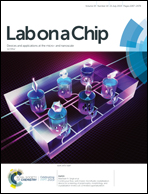Natural killer cell migration control in microchannels by perturbations and topography†
Abstract
Natural killer (NK) cells are lymphocytes which play an important role in the immune system by recognizing and killing potentially malignant cells without antigen sensitization, and could be utilized in cancer therapy. NK cell migration is an essential process to find and kill target cells, which is well known to be driven by the chemotaxis effect. NK cells also experience a topographical effect induced by the extracellular matrix (ECM) during their migration. However, topographical effects on NK cell locomotion in three dimensional (3D) environments are not well studied yet. In this work, polydimethylsiloxane based platforms containing microchannels with different types of perturbations and decorated with various surface patterns were fabricated to systematically study the topographical effect on NK cell migration with and without the chemotaxis effect. The results showed that perturbation sites in channels induced pauses and reversals in chemotaxis driven NK cell migration. Surface topography such as gratings in confined environments could introduce directional preference to NK cell movement even without chemoattractants. These findings showed that NK cell migration could be controlled by contact guidance, which provides future possibility to manipulate NK cell migration in controlled in vitro bioengineering systems. Results in this study showed that the complex topography of 3D microenvironments in the ECM could have significant effects on NK cell migration in different tissues and organs, and provided insight for explaining the dynamics of NK cell activities in clinical experiments.



 Please wait while we load your content...
Please wait while we load your content...